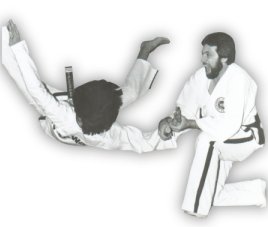Most martial arts practitioners are taught how to throw
someone. They are also taught how to roll and breakfall to
help avoid being injured during practice. But few are taught
how to defend themselves once they have been thrown to the
ground.
Of course if you are knocked unconscious, severely stunned or
injured when you are thrown, you may not be able to respond
to any further attacks. However, if you are able to "roll"
with the take-down or throw, you may be able to launch a
defense from the ground. Though this part of a martial
artist's training may be lacking in some areas, it is a vital
part of training which should be stressed. If practical
self-defense is a primary component of a student's
development, then ground-fighting should be addressed on a
regular basis.
Here are some factors to consider if you are thrown to the
ground:
- Your body position.
- The extent of your injuries.
- The position of the aggressor.
- The intensity of the situation.
- The environment.
- The type of follow-up attack the aggressor initiates.
Let's take a look at each of these factors and
how they could affect your actions.
Your body position: Have you landed on your side, on your
back, or perhaps face down? Are you facing the aggressor or
away from him? You only have a split second to assess your
position in order to determine your options for a defensive
maneuver, should the situation escalate. Develop defenses
which may be used from a wide variety of positions such as
facing upward, downward and to your side.
The extent of your injuries: Any injuries you may have
suffered as a result of your fall could reduce your
effectiveness to defend yourself. For example, if you have
injured one of your arms to the point where you are unable to
use it defensively, you would have to initiate a defense
which employs only one arm. Be sure to work on defenses
which require you to use only one arm so you will be better
prepared in such a situation.
 The position of the aggressor: Is the aggressor standing,
kneeling, sitting of top on you, holding on to one of your
arms, or have you in a hold? Practice defending yourself
when the aggressor is in each of these positions as well as
any additional ones you may think of. You can't assume he
will always throw you or take you down the same way. You
must try to prepare for as many variations of attacks as possible.
The position of the aggressor: Is the aggressor standing,
kneeling, sitting of top on you, holding on to one of your
arms, or have you in a hold? Practice defending yourself
when the aggressor is in each of these positions as well as
any additional ones you may think of. You can't assume he
will always throw you or take you down the same way. You
must try to prepare for as many variations of attacks as possible.
The intensity of the situation: There is a significant
difference between being pushed to the ground as opposed to
being thrown to the ground. Does the aggressor show intent
to do you great bodily harm? Does he have a weapon? Is
there more than one opponent? You should use only the amount of force
necessary to defend yourself, keeping in mind that your
actions should be directly proportionate to the intensity of
the aggressor's attack. Do not over react, while at the same
time do not use a technique which will not render you safe
from further danger of attack.
The environment: What is the surrounding area like? Are you
outside or inside? Is the ground snow-covered or dry? Are
there objects you may be able to use to defend yourself with?
Are there other people in the area which could be injured if
you use a certain defense (such as throwing the opponent)?
Is there room to maneuver or are you in a restricted area
which may limit your ability to apply certain techniques?
The type of follow-up the attacker initiates: After considering
the factors all ready mentioned, you will actually base your
defense on the type of attack the aggressor launches. For
example, he may try to punch you, or he may attempt to
maneuver you into a joint-locking technique, or he may
endeavor to apply a choke or hold. You may choose to wait
until he has initiated his attack before you begin your
counterattack. You could initiate your defense before he
attempts to attack again, such as kicking him or manipulating
him into a hold or throw. You should practice for both
contingencies.